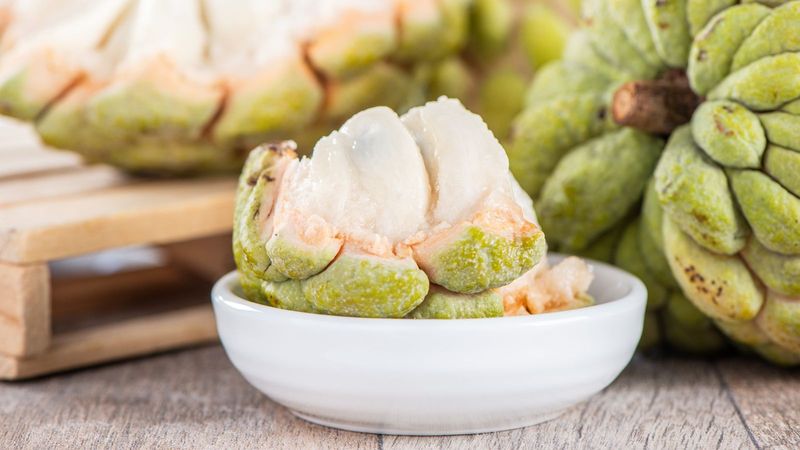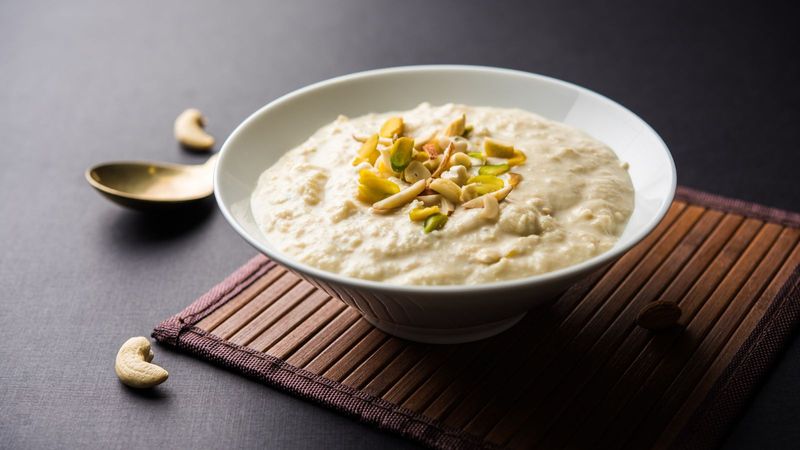While you are certainly familiar with rabdi’s cousin- the humble basundi- let us introduce you to a version of this very basundi that combines the richness of reduced, creamy milk with the sweetness and flavour of custard apples, i.e. sitafal. If you have tasted a good bowl of sitafal basundi before, you know what we’re talking about here! There’s no way you’re going back to a regular basundi, and for good reason. Sitafal basundi is a perfect choice for when you want to impress your guests with something unique or simply treat yourself to a special sweet. Whether you’re celebrating a festive occasion, hosting a party, or looking for a refreshing dessert, this sitafal basundi recipe will rise to the occasion and how.
All about sitafal basundi
Sitafal basundi is not just a dessert; it’s an experience. Think of the creamy, dreamy and oh-so-delicious lovechild of milk and sitafal as the kid who got it all. This delightful concoction combines the traditional richness of basundi, a thickened milk dessert, with the irresistible texture and mouthfeel of the sitafal. Besides, sitafal basundi is lighter than similar preparations like rabdi, which means you can stop counting the number of servings you relish. Do not take our word for it- try this basundi with a twist and thank us later!
Sitafal basundi ingredients

- 1 litre whole milk (full-fat milk)
- ¼ cup granulated sugar
- ½ teaspoon cardamom powder
- ¾ cup custard apple pulp
- ¼ cup chopped nuts (almond, pistachio, cashew)
- Rose petals to garnish (optional)
Sitafal basundi recipe

- Start with de-seeding the custard apples. Once seeds have been separated from the pulp, refrigerate the pulp while you get to the basundi.
- Start by pouring the full-fat milk into a heavy-bottomed pan.
- Bring it to a gentle boil over medium heat, stirring occasionally to prevent it from sticking to the bottom. This is where the magic begins!
- Once the milk reaches a boil, reduce the heat and let it simmer.
- Stir frequently and scrape the sides of the pan to collect the cream that forms. This process can take about 45 minutes to an hour, it’s worth every minute.
- As the milk thickens, it’s time to add the sugar, cardamom and chopped nuts of your choice. Continue to simmer the basundi until it reaches a thick, creamy consistency.
- Remove the pan from heat and cover it with a lid to prevent the formation of a cream (malai) layer. Allow it to cool completely.
- Once the basundi is cooled, add custard apple pulp to it and mix well.
- Chill the sitafal basundi and garnish with dried rose petals while serving.
Tips to nail the sitafal basundi of your dreams

1. Deseeding custard apples for sitafal basundi can be a time-consuming affair but here’s a quick hack to do this in less than 5 minutes. Cut the sitafal in half and scoop out the pulp into a food processor. Pulse or whip the pulp a few times, and you will have separated the seeds from the pulp. You can now just pick up the seeds from the pulp.
2. Basundi is all about time. Its richness and consistency build over time as milk cooks away and reduces slowly. So don’t rush it- sabr ka fal meetha hota hai, quite literally!
3. If you don’t have the luxury of time and need a shortcut, try making sitafal basundi with condensed milk. This will get your basundi to thicken slightly faster. To do this, use about 50% condensed milk and 50% full-fat milk. Remember to adjust the quantity of sugar you add in this case, especially if your condensed milk is sweetened.
4. Ripe custard apples are sweet by themselves, so feel free to adjust the amount of sugar you add to the sitafal basundi. You can also use jaggery instead of sugar for a slight variation in flavour and colour.
5. For a creamier basundi, choose buffalo or full-fat milk over cow milk. You can always stick to cow milk if you’d like, but make the switch if you’re looking to indulge.
6. To get the perfect texture and sweetness in your sitafal basundi, make sure the custard apples you use are ripe. It will make all the difference to the flavour as well.
Now that you’ve discovered the beauty of this sitafal basundi recipe, why don’t you give it a try the next time you’re in the mood for something special? Enjoy every spoonful, and don’t forget to share the joy with your loved ones!


_1719299261462_thumb_1200.jpeg?w=3840&q=75)

